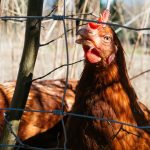Bantams and chickens are both popular choices for backyard poultry, but there are key differences between them. Bantams are smaller than standard chickens, with some breeds being only a quarter of the size of their larger counterparts. They are often called “miniature chickens” and are prized for their ornamental qualities, including unique feather patterns and colors.
Bantams are known for their friendly and docile nature, making them suitable for families with children or those seeking a more manageable bird. Standard chickens are larger and typically raised for meat and egg production. They come in various breeds, each with distinct characteristics.
Standard chickens are valued for their productivity, with some breeds laying up to 300 eggs annually. They are also raised for meat, making them popular for food production. The temperament of standard chickens varies by breed, but they are generally more independent and less friendly compared to bantams.
In conclusion, while both bantams and chickens are poultry, they differ in size, purpose, and temperament. Understanding these differences is crucial for providing appropriate care and housing for these birds.
Table of Contents
- 1 Creating a Suitable Living Environment for Bantams and Chickens
- 2 Providing Proper Nutrition for Bantams and Chickens
- 3 Managing Social Dynamics and Pecking Order
- 4 Addressing Health and Veterinary Care for Bantams and Chickens
- 5 Integrating Bantams and Chickens into a Flock
- 6 Tips for Keeping Bantams and Chickens Happy and Healthy Together
- 7 FAQs
- 7.1 What are bantams and chickens?
- 7.2 Can bantams and chickens be kept together?
- 7.3 What are the considerations for keeping bantams and chickens together?
- 7.4 Do bantams and chickens have different space requirements?
- 7.5 What should be considered regarding the temperament of bantams and chickens?
- 7.6 Do bantams and chickens have different nutritional needs?
- 7.7 Are there any special considerations for keeping bantam roosters with chicken hens?
Key Takeaways
- Bantams are smaller in size compared to standard chickens and have different behavioral characteristics
- Provide a spacious and secure coop with separate nesting areas for bantams and chickens to live together harmoniously
- Offer a balanced diet with appropriate protein levels for both bantams and chickens
- Understand and manage the pecking order within the flock to prevent aggression and bullying
- Regularly monitor the health of both bantams and chickens and seek veterinary care when necessary to prevent and treat illnesses
Creating a Suitable Living Environment for Bantams and Chickens
Secure and Predator-Proof Housing
When it comes to creating a suitable living environment for bantams and chickens, a secure and predator-proof coop or housing structure is essential. This will protect them from potential threats such as predators and harsh weather conditions. The coop should be well-ventilated and provide enough space for the birds to roost, nest, and move around comfortably.
Comfortable and Clean Living Conditions
In addition to a secure coop, it’s important to provide adequate bedding such as straw or wood shavings to keep the coop clean and dry. This will help maintain a healthy environment for the birds.
Outdoor Space and Enrichment
Bantams and chickens also require access to a secure and spacious outdoor area where they can forage, dust bathe, and exercise. Providing enrichment such as perches, dust bathing areas, and toys can help keep the birds mentally and physically stimulated. It’s also crucial to ensure that the outdoor area is fenced off to prevent the birds from wandering off and to protect them from potential predators.
By providing a secure coop, comfortable and clean living conditions, and ample outdoor space for foraging and exercise, you can create a suitable living environment for bantams and chickens that will keep them happy and healthy.
Providing Proper Nutrition for Bantams and Chickens

Proper nutrition is essential for the health and well-being of bantams and chickens. Both bantams and chickens require a balanced diet that includes a combination of commercial poultry feed, fresh water, and supplemental treats. A high-quality commercial poultry feed formulated specifically for bantams or standard chickens should serve as the foundation of their diet.
The feed should contain the necessary nutrients, vitamins, and minerals to support their growth, egg production (in the case of hens), and overall health. In addition to commercial feed, bantams and chickens can benefit from supplemental treats such as fruits, vegetables, mealworms, and scratch grains. These treats should be offered in moderation and should not exceed more than 10% of their total diet.
It’s important to avoid feeding them foods that are high in salt, sugar, or fat, as these can be harmful to their health. Fresh water should be available at all times, especially during hot weather or when the birds are laying eggs. Waterers should be kept clean and free of debris to prevent contamination.
Providing proper nutrition for bantams and chickens is essential for supporting their overall health, productivity, and longevity.
Bantams and chickens are social animals that have a complex social hierarchy known as the pecking order. Understanding and managing social dynamics within a flock is important for maintaining harmony and minimizing aggression among the birds. The pecking order is established through various social interactions such as pecking, posturing, and vocalizations, with dominant individuals asserting their authority over subordinate ones.
When introducing new birds into an existing flock, it’s important to do so gradually to minimize stress and aggression. Providing enough space, food, and resources can help reduce competition among the birds. Additionally, providing multiple feeding and watering stations can help prevent dominant individuals from monopolizing these resources.
In some cases, aggressive behavior such as pecking or bullying may occur within a flock. It’s important to monitor the birds closely and intervene if necessary to prevent injuries. Separating aggressive individuals or providing hiding spots within the coop or run can help reduce conflict among the birds.
Overall, managing social dynamics and the pecking order within a flock is essential for promoting a peaceful and harmonious environment for bantams and chickens.
Addressing Health and Veterinary Care for Bantams and Chickens
Maintaining the health of bantams and chickens is crucial for their overall well-being and productivity. Regular health checks should be conducted to monitor the birds for any signs of illness or injury. Common health issues in poultry include respiratory infections, parasites, nutritional deficiencies, and reproductive disorders.
It’s important to familiarize yourself with common signs of illness in poultry such as lethargy, decreased appetite, abnormal droppings, or respiratory symptoms. In addition to regular health checks, providing proper veterinary care is essential for addressing any health concerns that may arise. Finding a veterinarian with experience in poultry medicine can be beneficial for obtaining accurate diagnoses and treatment plans.
Vaccinations may also be recommended depending on the region and specific health risks present in the area. Preventative measures such as maintaining a clean coop, providing proper nutrition, and practicing good biosecurity can help reduce the risk of disease transmission within a flock. Addressing health concerns promptly and providing proper veterinary care is essential for maintaining the health and well-being of bantams and chickens.
Integrating Bantams and Chickens into a Flock

Pre-Integration Preparation
Providing a separate but adjacent living space where the birds can see and hear each other can help them become familiar with one another before being fully integrated.
Gradual Introduction
Once the birds have become accustomed to each other’s presence, they can be gradually introduced under close supervision. It’s important to monitor their interactions closely to ensure that no aggressive behavior occurs. Providing multiple feeding stations and hiding spots within the coop or run can help reduce competition among the birds.
Managing Integration Challenges
In some cases, temporary separation or reintegration may be necessary if aggressive behavior occurs. It’s important to be patient during the integration process and to intervene if necessary to prevent injuries. Overall, integrating new bantams or chickens into an existing flock requires patience, careful monitoring, and proactive management to ensure a smooth transition.
Tips for Keeping Bantams and Chickens Happy and Healthy Together
Keeping bantams and chickens happy and healthy together involves providing proper care, nutrition, housing, and social management. Here are some additional tips for maintaining the well-being of these birds: – Provide ample space: Ensuring that bantams and chickens have enough space to move around comfortably is essential for preventing stress and aggression within the flock.
– Monitor social dynamics: Regularly observing the interactions between birds can help identify any potential issues such as bullying or aggression.
– Offer enrichment: Providing enrichment such as perches, dust bathing areas, toys, or hanging treats can help keep the birds mentally stimulated.
– Practice good biosecurity: Implementing biosecurity measures such as maintaining a clean coop, quarantining new birds, and preventing contact with wild birds can help reduce the risk of disease transmission.
– Seek veterinary care when needed: If you notice any signs of illness or injury in your bantams or chickens, seek veterinary care promptly to address any health concerns.
– Provide proper nutrition: Offering a balanced diet that includes commercial poultry feed, fresh water, and supplemental treats is essential for supporting the health of bantams and chickens.
– Be patient during integration: Integrating new birds into an existing flock requires patience and careful monitoring to ensure a smooth transition. By following these tips and providing proper care, nutrition, housing, social management, and veterinary care, you can help ensure that your bantams and chickens live happy and healthy lives together in your backyard flock.
If you’re interested in keeping bantams and chickens together, you may also want to check out this article on The Chicken Coop Country Diner. It provides valuable information on creating a comfortable and functional space for your feathered friends to live and dine in.
FAQs
What are bantams and chickens?
Bantams are small breeds of chickens, typically one-fourth to one-fifth the size of standard chicken breeds. Chickens, on the other hand, are domesticated fowl that are commonly raised for their eggs and meat.
Can bantams and chickens be kept together?
Yes, bantams and chickens can be kept together in the same coop and run. However, it’s important to consider the size and temperament of the birds to ensure they can coexist peacefully.
What are the considerations for keeping bantams and chickens together?
When keeping bantams and chickens together, it’s important to consider the size of the coop and run, the temperament of the birds, and their individual space and nutritional needs.
Do bantams and chickens have different space requirements?
Yes, bantams generally require less space than standard chickens due to their smaller size. However, it’s important to provide enough space for all birds to move around comfortably and engage in natural behaviors.
What should be considered regarding the temperament of bantams and chickens?
Bantams and chickens can have different temperaments, so it’s important to observe their behavior and ensure that they are not overly aggressive towards each other. Introducing new birds gradually can help minimize conflicts.
Do bantams and chickens have different nutritional needs?
Bantams and chickens have similar nutritional needs, but bantams may require smaller feed and water containers due to their size. It’s important to provide a balanced diet for all birds to ensure their health and well-being.
Are there any special considerations for keeping bantam roosters with chicken hens?
When keeping bantam roosters with chicken hens, it’s important to ensure that the roosters do not become overly aggressive towards the hens. Providing enough space and multiple hens for each rooster can help minimize aggression.
Meet Walter, the feathered-friend fanatic of Florida! Nestled in the sunshine state, Walter struts through life with his feathered companions, clucking his way to happiness. With a coop that’s fancier than a five-star hotel, he’s the Don Juan of the chicken world. When he’s not teaching his hens to do the cha-cha, you’ll find him in a heated debate with his prized rooster, Sir Clucks-a-Lot. Walter’s poultry passion is no yolk; he’s the sunny-side-up guy you never knew you needed in your flock of friends!







